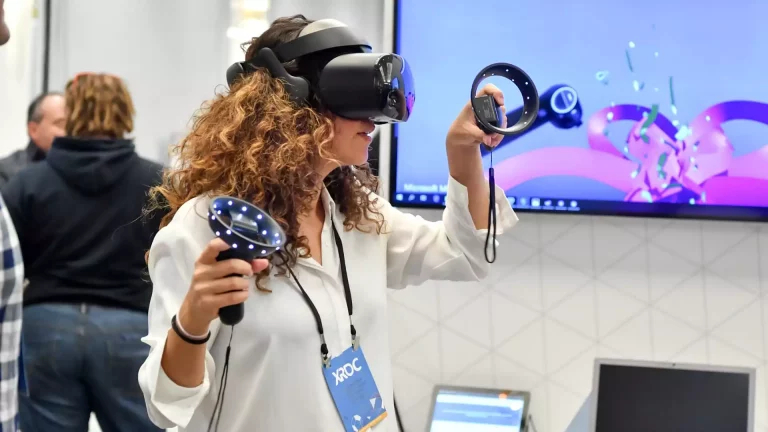
Virtual and augmented reality were once the domain of science fiction. But they’re increasingly applied to a varied mix of industries and use cases globally. For example, one growing application is employee safety training. Let’s jump into five ways this is playing out today…
1. Risk Management
In reality, it’s challenging to train employees in necessary safety procedures without putting them at risk. It’s inherent in the process itself. That’s where VR and AR can help. By offering simulated environments, it has all the benefits of experiential learning, but without the hazards.
For example, Seaberry’s Soldamatic system trains and certifies welding professionals using welding helmets that have AR headsets built-in. Using the actual equipment (soldering iron and helmet) they go through a series of simulated exercises to master their craft, all without getting burnt.
And the best part: welders are already accustomed to strapping on helmets so VR and AR’s head-worn adoption barriers aren’t an issue.
2. Memory Recall
Remember when you were at school, and you’d be sitting at your desk not taking in the lesson? Now picture adult employees in the same situation during training sessions. The same boredom and distractions are present many years later, though the stakes are higher given that they’re meant to learn critical safety protocols.
VR’s immersive qualities make it more engaging than traditional lecture or textbook-based learning. This involves simulated environments in a VR headset that immerse a trainee in situations that they need to prepare for. So far this has been used in several places, from quarterbacks to Walmart clerks.
Besides engagement level, it’s more effective: VR’s visceral qualities are proven to be better at brain encoding – a fancy word for learning. With visual learning from technologies like AR and VR, this can happens to the tune of 70 percent greater memory recall according to Zappar.
3. Pacing & Practice
Everyone learns at different speeds, which is one of the downsides of traditional classroom-based learning. While one student or trainee can process everything right away, another may need longer to absorb the knowledge. Meanwhile, the instructor can only go at one speed. With VR, everyone can learn at their own pace, as the experience is specific to their personal immersive session.
For the same reason, trainees can get additional practice by going over sessions and sequences several times if they need to. In addition to VR’s ability to achieve brain encoding more effectively as noted above, repetition can amplify that effect. After all, practice makes perfect.
Data Dive: How Effective is VR Training?
4. LFH (Learning from Home)
One silver lining of the Covid era has been to re-condition the world’s thinking on work and productivity. It turns out that several job functions – especially for knowledge workers – can be done remotely. And there are second-order effects such as fewer travel accidents, transit fatigue, and the cost of commercial real estate.
Now, in the waning stages of the pandemic, it appears that several companies will maintain remote and hybrid work policies.
But as it relates to safety training, this means it will be difficult to get everyone together at the same time and place to conduct traditional sessions. This is where VR comes in once again to save the day. In addition to all the above benefits, the technology doesn’t require physical presence and is remote-work friendly.
The AR Show: Training for Quarterbacks & Walmart Clerks
5. Augmented Learning
Zeroing in on mobile AR, it likewise has unique capabilities that can aid safety training. For example, it can enhance and enliven training materials so that the page comes to life. Using AR activation markers in traditional print or online training materials, animated sequences can be launched to demonstrate key concepts in motion. This offers the demonstrable benefits of 3D elements that can play out on a trainee’s coffee table.
Case Study: Medtronic Lessens Training Costs with AR
Moving Target
So there you have it. These are just a few of the ways that AR and VR are transforming safety training. And this list will likely grow as the technology itself does. Like other areas of AR and VR applicability, it will be a moving target, and it’s already showing promise and value today. Expect more AR and VR benefits to reveal themselves, making employee training more immersive, safe, and effective.
 Sara Sparrow is a technical writer and project coordinator for Essay Writer, Assignment Writing Service, and Big Assignments.
Sara Sparrow is a technical writer and project coordinator for Essay Writer, Assignment Writing Service, and Big Assignments.






